Disclosure: Meeple Mountain received a free copy of this product in exchange for an honest, unbiased review. This review is not intended to be an endorsement.
Undergrove, the latest title from Elizabeth Hargrave and Mark Wootton, is on its way to crowdfunding in the coming days. Players take up the role of douglas fir trees attempting to spread their seedlings about a mushroom forest replete with elemental resources.
The game itself is a tile-laying, area and resource management affair in which players are cooperatively building the game’s engine in the form of the forest floor and then determining the most fruitful ways to exploit the fungi for dendrological gains.
Remember this is a late prototype, so the descriptions here are only relevant to the pre-campaign conversation. My aim is to give you a basic understanding and point out the way the game feels at this moment in the process.
Gameplay
Undergrove takes place on an expanding map of mushroom tiles with scalloped corners. These scalloped corners leave cutouts to place seedling discs. The seedlings then have access to lay roots on each of the four adjoining tiles, gaining access to their abilities and, hopefully, their victory points. During the game, the seedlings absorb carbon from the mushrooms, growing to eventually become small trees.
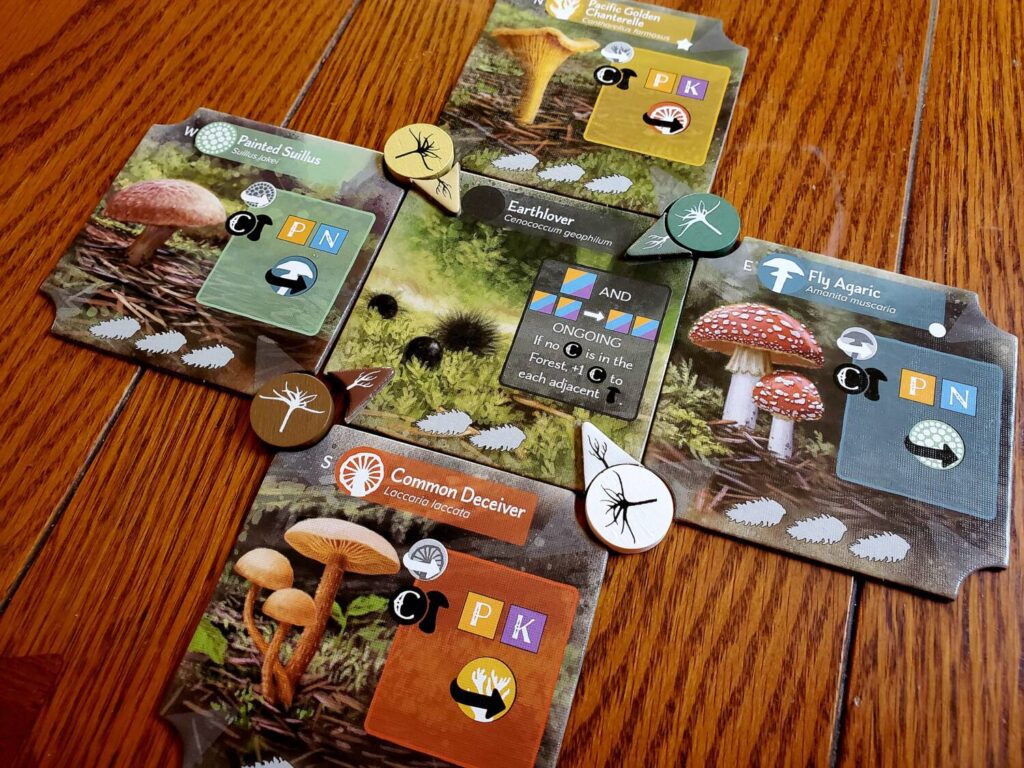
For the most part, the abilities on the mushroom tiles allow for the exchange of resources and the expedition of this absorption and growth process. Players wheel and deal in carbon, nitrogen, phosphorus, and potassium to achieve their varied ends. In addition, four activation tokens flip and eventually reset as another type of currency.
Players take one of five actions on a turn. They can activate the ability of a mushroom on which they have roots by paying the cost and enjoying the benefit. They can absorb carbon from a mushroom tile with a root, spending resources to move the carbon around the board beforehand if necessary. Reproduction involves laying a new seedling disc along with one root. Partnering is laying roots on any seedling. Both reproduction and partnering come with the option of laying a new mushroom into the forest. Photosynthesis is the upkeep turn, replenishing carbon, resetting the activation tokens, and refreshing the player’s hand of mushroom tiles.

Mushroom tile abilities are pretty sensible. Some enable flipping one activation token down to refresh two others before taking another action (usually because specific tokens are needed for specific actions). Some cost a carbon and a resource in exchange for two other resources and a refreshed activation token. Others you pay two carbons for four resource cubes. We also had access to some of the secretive stretch goal tiles, which, I must say, are more or less essential so I hope they are included in the game!
Every time a player absorbs carbon onto a seedling, they move up one space on a carbon track that serves as the game’s timer. When one player reaches the top, there is one additional round before scoring commences.
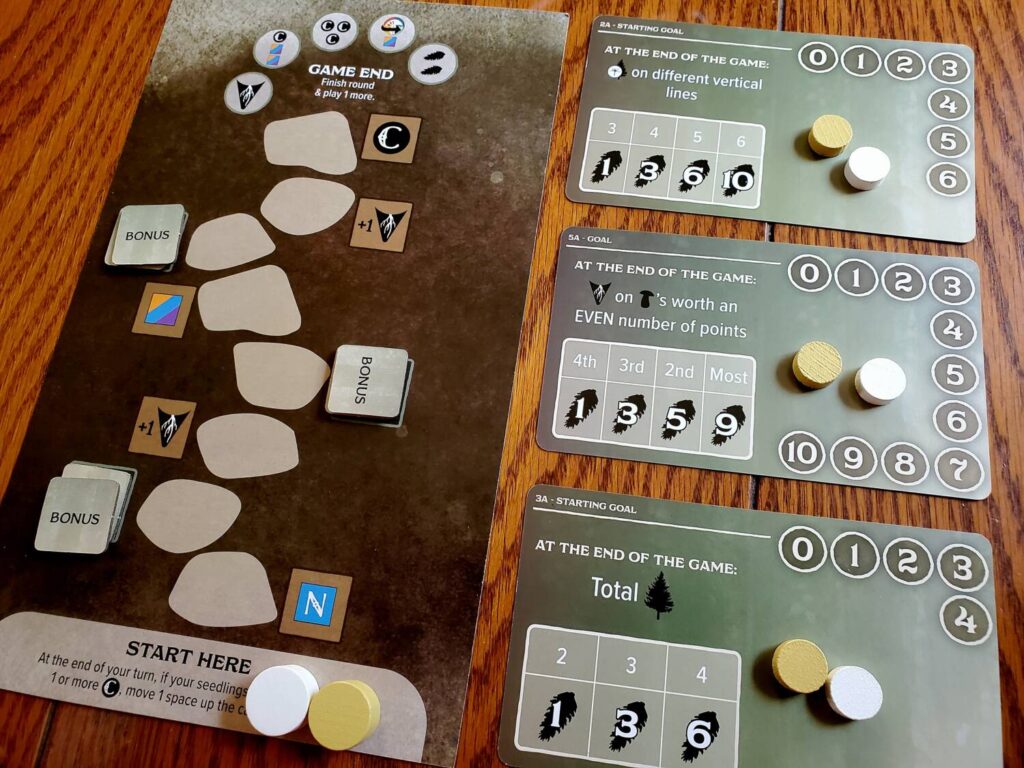
Each game will include three shared goals. These involve having the most trees or roots, or setting seedlings out in various patterns on the board. Players receive points based on their accomplishments. Each seedling and tree will also score points based on the number of carbons that have been absorbed. For every carbon on the seedling, one of the four roots will earn the points printed on its mushroom tile. Trees score all four. Finally, players will earn a few extra points based on bonus tokens gathered from the carbon track and leftover resources.
Thoughts
Playing a game more than a year from its eventual release is challenging, so please take all of my critical comments with a large and necessary grain of salt. Undergrove has the makings of a rock solid game, but I’m not sure it’s there yet.
The economy is obviously designed to be tight, but here the tightness feels artificial. Take carbon as the key example. The photosynthesize action is the only way to gain carbon in the game. Players gain two, plus extra if they spend nitrogen cubes, which only exist in the game to throw away or buy extra carbon (red flag). Now there is a tile that gives you four resource cubes of your choice, which can certainly buy plenty of carbon, but the cubes come by spending…two carbons. There are other tiles that might give you three nitrogen for one carbon, but still, the net gain is akin to wheels spinning in the mud. This creates an environment of microtransactions that makes the game tight for the sake of being tight. Rather than being excited by what’s possible, many of the turns feel small, insignificant, and, as a result, tame.
For this reason, the game arc is a slog starting in turn four when your starting resources run dry. We found ourselves wondering why we weren’t given two actions per turn just to add some spice and enliven the pace (our first experience at four players was well over two). When you consider that you need the other types of cubes—and more carbon—to do nearly everything in the game, we all felt like we were stuck in a Groundhog Day scenario of constricted collecting and throttled trading every two or three turns just to get at the game’s core narrative.
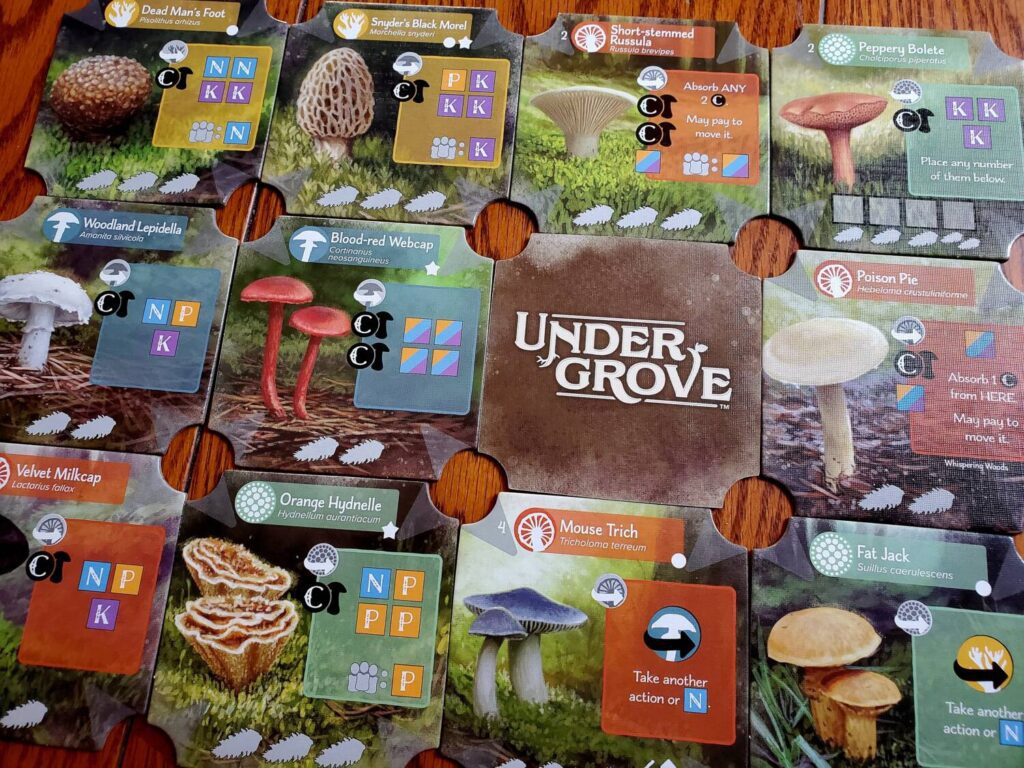
While I am on the subject of photosynthesis, the action itself renders several of the forest tiles less useful until the last few turns. Because the maintenance turn is ever-necessary and includes refreshing the activation tokens, the actions in the forest that duplicate this action are not really enticing early in the game (even though they come with a second immediate action). Players may lay roots on them early, only to find they slip from consciousness. The last few rounds are a bit more frantic as players measure out what is possible, and photosynthesis is not always the efficient choice in the end, forcing everyone to remember those other tiles exist.
Undergrove is the type of game that could, in theory, move quickly. A two-player bout should finish in under 45 minutes, given two requisites: no chatting and a willful persistence to strategically move the game forward. I wish I had counted, but I feel as though the two-player affair included 30+ turns? A table of four conversational min-maxers will push the forest to its point potential and only then travel the carbon track to see the final score. The trouble is, that will take a long (read: looong) time and the scores will be nearly identical.
One final nitpick: the base setup. With the current collection of tiles, I would probably add a house rule to eliminate the game’s center tile in favor of any other tile in the bunch. The existing tile allows for taking one free cube and exchanging two for two others. In multiple plays, this tile was hardly used. It is essentially punitive—taking one cube as a whole turn—yet everyone is required to lay roots there during setup (for two endgame points) just in case they get stuck. By the end of the first round of turns every other tile on the board is more useful and the cube economy is so tight that there aren’t often enough to exchange. In my experience, we’ve lived almost turn-to-turn for most of the game. I would eliminate this tile in a heartbeat and have every player’s turn start by taking a cube of choice just to loosen the economy and make the one shared tile more interesting (and potentially semi-cooperative—read on).
Remember the salt
At this point you might expect me to say Undergrove is a miss. But I won’t. In fact, I’ll say that I have the highest hopes for it. If nothing changes, I’m not sure I’ll line up to buy. But if there are even a few final tweaks in the year to come—and with Hargrave, Wootton, and the team at AEG behind the reins, I believe there will be—the sky’s the limit for this mushroom forest.
I really like the way the mechanical concepts in Undergrove tell a story. They are crystal clear from the beginning: lay seedlings, expand roots, grow trees, score points. The ecosystem makes sense on the table; and Elizabeth Hargrave’s designer diary entries have proven the amount of research and development involved in getting even this far. The tiles are stunning (mushrooms have a peculiar beauty, don’t they?). I love the scalloped corners fit for the discs. I love dropping the roots and shuffling the carbon to grow up trees. I may wish for a few more combos, but the underlying ideas work very well together.
The design team included a four-player learning scenario designed for the first play. I worked through this on my own before teaching the game to others. It was super helpful, and I would also say the rulebook is nicely written and well organized such that the aids were just icing on the cake.
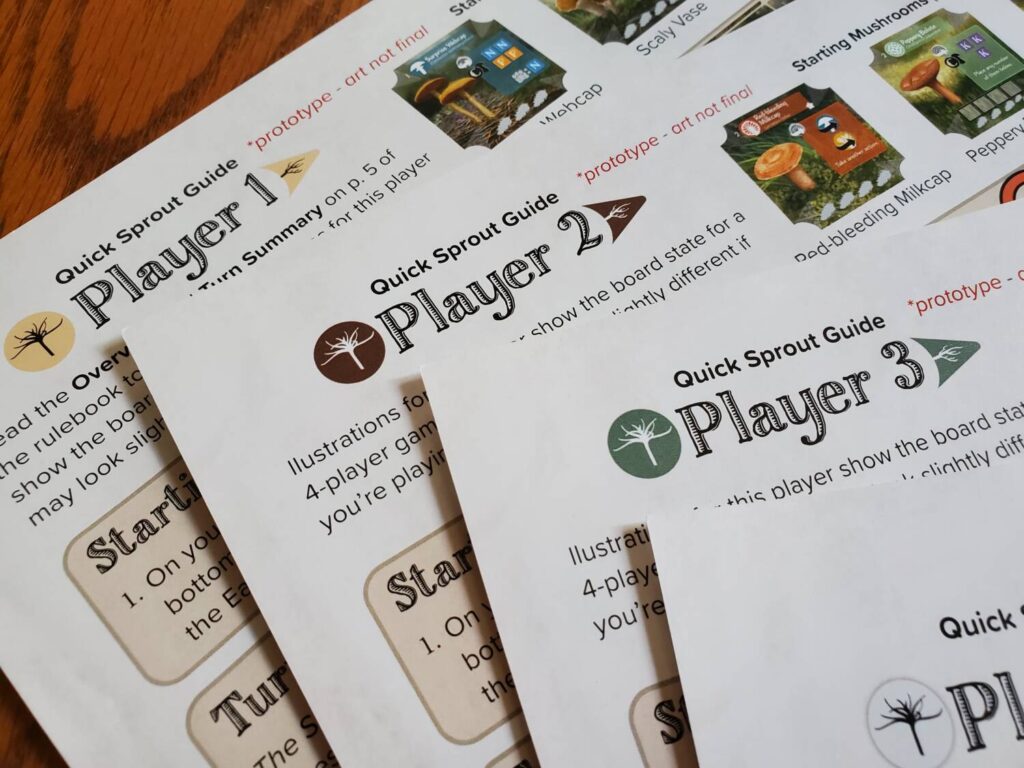
There are some tiles whose score is determined by a bit of semi-cooperative action, and those were a collective hit. In fact, I would love to see more in the same spirit. There is a bit of interaction in the forest apart from those tiles, but I’ll gladly take more as the rest comes in the form of “taking a potentially lucrative spot first.” I would love to see a tile that gets stronger with four seedlings or four trees, or one that diminishes with increased player presence just to add a defensive tension to the forest. Area management games thrive on this sort of contentiousness.
On the table, as is so often the case with even a late prototype, Undergrove feels like growing pains. There is probably a tweak in the minutiae that will spring the entire forest to life. Without fail, my opinion (and my hope) was shared by folks at my table.
Closing
I promised myself I wouldn’t use the W-word, but the birds have something to say to the mushrooms. The beauty of engine-building is the sense of accomplishment in building an exciting turn, a moment where you say, “ooh, now I can do that, too!” Let’s call it an engine of possibility. There is a collective engine here in the forest, too, but it is more an engine of availability. Every new root stands alone as another micro-transaction, not part of a chain; just another isolated link that makes you say, “oh, now I can do that, too.” Maybe it’s a small difference to some, but that extra lowercase o makes all the difference in the feel of a game.
Unexpectedly, I keep finding myself thinking of Orichalcum, another map-building, resource-swapping, objective-snagging title from Pandasaurus and Bruno Cathala. The games are wholly different; and yet the mechanisms there also created a bit of an early map-building drawl (albeit a private map). Cathala’s shared goals and deep combos quickly create a tipping point that leads to a chaotic home stretch. In the end I thought that one was too jarring. But I would love something in between, a tension in possibilities delicious enough to pull you out of the mud without making you feel like you lost a limb in the process.
I’m not sure what the answers are, but then again I’m not a designer. I just sit at the table looking for a good time. [Insert underwhelming fungi joke] I intend to keep an eye on Undergrove, because I love seeing how the process works out. If you’re interested in the mushroom forest, check out the Kickstarter page for more information.


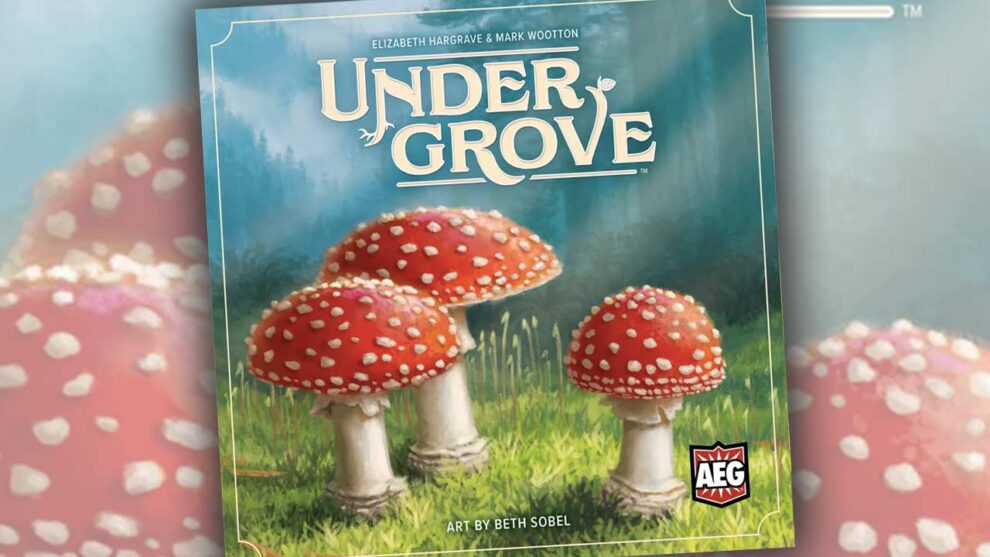


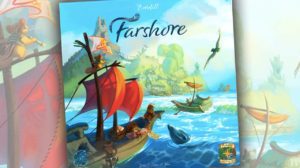
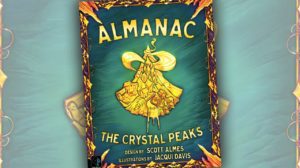





Very good, and quite honest, review. I appreciate both your critique of the game as well as the admission that those critiques could be rendered moot once the final version of the game is released to backers.
As a fan of Elizabeth Hargrave’s work (and someone quite appreciative of the work Mark Wootton did with her on hew gorgeous game Mariposas), I have backed this game quite early. I am really looking forward to getting this.
I would like to ask something: can you please, please, write a follow-up review of this game when you get a copy of the final product and have a chance to compare it to this? I would really like your insight into how this played out.
Thanks again.
Thank you for the kind words! We always chat among ourselves here that Kickstarters are difficult to review. On the one hand, they are exciting and fresh, but they are also never complete and sometimes await (as with Undergrove) the possibility of a $400,000 campaign complete with stretch goals and simple, often pre-planned, modifications to bring the game to another level of enjoyment.
I am glad AEG has found so much success with this title. Assuming the finalized copy arrives, you can be there will either be an addendum here or a new review if warranted. I love revisiting reviews, so I’ll be nothing but happy if I’m left to eat my hesitant words. Haha.